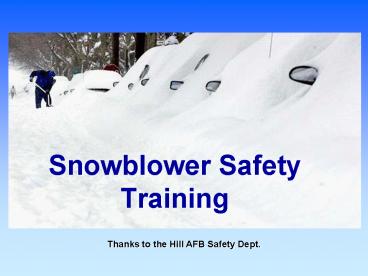Snowblower Safety Training - PowerPoint PPT Presentation
1 / 20
Title:
Snowblower Safety Training
Description:
A single-stage blower whirls the auger at a very high speed to cut and throw the snow. The two-stage blower uses an additional auger for throwing snow out of the path. – PowerPoint PPT presentation
Number of Views:228
Avg rating:3.0/5.0
Title: Snowblower Safety Training
1
Snowblower Safety Training
Thanks to the Hill AFB Safety Dept.
2
(Or)The I Dont Want To Shovel Any More Blues
3
Important!
- Read the instruction manual and precautions
before trying to start your blower. - Your first priority isnt to start the mower and
get to workit is to read the manual and
understand how to work effectively.
4
Types Of Snowblowers
- There are two basic types
- single-stage and two-stage.
- A single-stage blower whirls the auger at a very
high speed to cut and throw the snow. - The two-stage blower uses an additional auger for
throwing snow out of the path.
5
- Though two-stage blowers are usually more
enclosed, the augers on both types can injure
fingers. - Exposed gears, drive chains, and belts can also
cause injuries
6
Common Sense
- To avoid back injury, get help if you must lift
the blower to and from its storage place. - Before or during snowblower operation do not
consume any alcoholic beverages or drugs that may
interfere with the safe operation.
7
Before Operating The Snowblower
- Ensure that you wear the appropriate Personnel
Protective Equipment (PPE) gloves protective
goggles sturdy, non-skid boots
8
- Inspect the area in which you are going to clear
snow. - Remove debris and other obstacles the snowblower
might strike or throw, as they may cause injury
or damage to the snowblower.
9
- If you hit an obstacle while operating the
snowblower, stop the engine immediately, and
check for damage. - Damaged equipment may increase the possibility of
injury during operation. Inspect the snowblower
before operating it. - Repair any damage and correct any malfunction
before operation, following the operators manual
instructions
10
Operating The Snowblower
- Know how to stop the snowblower quickly and
understand the operations of all controls. - Keep people away from the area of operation to
avoid injury from flying debris and contact with
the snowblower.
11
- Never permit anyone to operate the snowblower
without proper instruction. - If people suddenly appear in front of the
snowblower while it is in operation, immediately
release the auger and drive clutch levers to stop
the snowblower and avoid possible injury from
rotating auger blades.
12
- Never use the snowblower to clear snow from a
gravel road or driveway, as rocks may be picked
up and ejected. - Ejected gravel and rocks may cause injury to
bystanders.
13
- Adjust the discharge chute to avoid hitting the
operator, bystanders, windows, and other objects
with ejected snow. - Stay clear of the snow discharge chute while the
engine is running.
14
- Do not use the snowblower when visibility is
poor. - Under conditions of poor visibility, there is a
greater risk of striking an obstacle or causing
injury.
15
- The snowblower may overturn on steep slopes if
left unattended, causing injury to the operator
or bystanders. - To avoid overturning, be careful when changing
the direction of the snowblower while operating
it on a slope. - Do not use the snowblower to remove snow from
roofs.
16
- If the snow discharge chute becomes clogged, stop
the engine and use a wooden stick to unclog it. - Never put your hand into the snow discharge chute
while the engine is running you can seriously
injure yourself.
17
- Refuel in a well-ventilated area with the engine
stopped. - Do not overfill the fuel tank, and make sure the
filler cap is closed securely after refueling.
18
- Never run the engine in an enclosed or confined
area. - Exhaust contains poisonous carbon monoxide gas.
Exposure can cause loss of consciousness and may
lead to death.
19
- The muffler becomes very hot during operation and
remains hot for a while after stopping the
engine. - Be careful not to touch the muffler while it is
hot. - Let the engine cool before storing the snowblower
indoors.
20
- While operating the snowblower, hold the handle
firmly and walk, dont run. - Always keep equipment in good operating
condition. - Always keep guards and shields in place.































